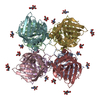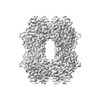+ Open data
Open data
- Basic information
Basic information
| Entry |  | |||||||||
|---|---|---|---|---|---|---|---|---|---|---|
| Title | Single particle analysis of recombinant human MFAP4 | |||||||||
 Map data Map data | D2 map after Relion4 postprocess and z-axis flip | |||||||||
 Sample Sample |
| |||||||||
 Keywords Keywords | MFAP4 Octamer Extracellular Matrix / CELL ADHESION | |||||||||
| Function / homology |  Function and homology information Function and homology informationregulation of collagen metabolic process / elastic fiber / microfibril / elastic fiber assembly / UV protection / Molecules associated with elastic fibres / cellular response to UV-B / supramolecular fiber organization / collagen-containing extracellular matrix / cell adhesion ...regulation of collagen metabolic process / elastic fiber / microfibril / elastic fiber assembly / UV protection / Molecules associated with elastic fibres / cellular response to UV-B / supramolecular fiber organization / collagen-containing extracellular matrix / cell adhesion / extracellular space / extracellular region Similarity search - Function | |||||||||
| Biological species |  Homo sapiens (human) Homo sapiens (human) | |||||||||
| Method | single particle reconstruction / cryo EM / Resolution: 3.55 Å | |||||||||
 Authors Authors | Wozny MW / Nelea V | |||||||||
| Funding support |  Canada, 2 items Canada, 2 items
| |||||||||
 Citation Citation |  Journal: Nat Commun / Year: 2024 Journal: Nat Commun / Year: 2024Title: Microfibril-associated glycoprotein 4 forms octamers that mediate interactions with elastogenic proteins and cells. Authors: Michael R Wozny / Valentin Nelea / Iram Fatima S Siddiqui / Shaynah Wanga / Vivian de Waard / Mike Strauss / Dieter P Reinhardt /   Abstract: Microfibril-associated glycoprotein 4 (MFAP4) is a 36-kDa extracellular matrix glycoprotein with critical roles in organ fibrosis, chronic obstructive pulmonary disease, and cardiovascular ...Microfibril-associated glycoprotein 4 (MFAP4) is a 36-kDa extracellular matrix glycoprotein with critical roles in organ fibrosis, chronic obstructive pulmonary disease, and cardiovascular disorders, including aortic aneurysms. MFAP4 multimerises and interacts with elastogenic proteins, including fibrillin-1 and tropoelastin, and with cells via integrins. Structural details of MFAP4 and its potential interfaces for these interactions are unknown. Here, we present a cryo-electron microscopy structure of human MFAP4. In the presence of calcium, MFAP4 assembles as an octamer, where two sets of homodimers constitute the top and bottom halves of each octamer. Each homodimer is linked together by an intermolecular disulphide bond. A C34S missense mutation prevents disulphide-bond formation between monomers but does not prevent octamer assembly. The atomic model, built into the 3.55 Å cryo-EM map, suggests that salt-bridge interactions mediate homodimer assembly, while non-polar residues form the interface between octamer halves. In the absence of calcium, an MFAP4 octamer dissociates into two tetramers. Binding studies with fibrillin-1, tropoelastin, LTBP4, and small fibulins show that MFAP4 has multiple surfaces for protein-protein interactions, most of which depend upon MFAP4 octamer assembly. The C34S mutation does not affect these protein interactions or cell interactions. MFAP4 assemblies with fibrillin-1 abrogate MFAP4 interactions with cells. | |||||||||
| History |
|
- Structure visualization
Structure visualization
| Supplemental images |
|---|
- Downloads & links
Downloads & links
-EMDB archive
| Map data |  emd_42394.map.gz emd_42394.map.gz | 117 MB |  EMDB map data format EMDB map data format | |
|---|---|---|---|---|
| Header (meta data) |  emd-42394-v30.xml emd-42394-v30.xml emd-42394.xml emd-42394.xml | 15 KB 15 KB | Display Display |  EMDB header EMDB header |
| FSC (resolution estimation) |  emd_42394_fsc.xml emd_42394_fsc.xml | 14.7 KB | Display |  FSC data file FSC data file |
| Images |  emd_42394.png emd_42394.png | 91.3 KB | ||
| Filedesc metadata |  emd-42394.cif.gz emd-42394.cif.gz | 5.8 KB | ||
| Others |  emd_42394_half_map_1.map.gz emd_42394_half_map_1.map.gz emd_42394_half_map_2.map.gz emd_42394_half_map_2.map.gz | 96.9 MB 96.9 MB | ||
| Archive directory |  http://ftp.pdbj.org/pub/emdb/structures/EMD-42394 http://ftp.pdbj.org/pub/emdb/structures/EMD-42394 ftp://ftp.pdbj.org/pub/emdb/structures/EMD-42394 ftp://ftp.pdbj.org/pub/emdb/structures/EMD-42394 | HTTPS FTP |
-Validation report
| Summary document |  emd_42394_validation.pdf.gz emd_42394_validation.pdf.gz | 951.9 KB | Display |  EMDB validaton report EMDB validaton report |
|---|---|---|---|---|
| Full document |  emd_42394_full_validation.pdf.gz emd_42394_full_validation.pdf.gz | 951.4 KB | Display | |
| Data in XML |  emd_42394_validation.xml.gz emd_42394_validation.xml.gz | 18.3 KB | Display | |
| Data in CIF |  emd_42394_validation.cif.gz emd_42394_validation.cif.gz | 24.2 KB | Display | |
| Arichive directory |  https://ftp.pdbj.org/pub/emdb/validation_reports/EMD-42394 https://ftp.pdbj.org/pub/emdb/validation_reports/EMD-42394 ftp://ftp.pdbj.org/pub/emdb/validation_reports/EMD-42394 ftp://ftp.pdbj.org/pub/emdb/validation_reports/EMD-42394 | HTTPS FTP |
-Related structure data
| Related structure data |  8un7MC M: atomic model generated by this map C: citing same article ( |
|---|---|
| Similar structure data | Similarity search - Function & homology  F&H Search F&H Search |
- Links
Links
| EMDB pages |  EMDB (EBI/PDBe) / EMDB (EBI/PDBe) /  EMDataResource EMDataResource |
|---|---|
| Related items in Molecule of the Month |
- Map
Map
| File |  Download / File: emd_42394.map.gz / Format: CCP4 / Size: 125 MB / Type: IMAGE STORED AS FLOATING POINT NUMBER (4 BYTES) Download / File: emd_42394.map.gz / Format: CCP4 / Size: 125 MB / Type: IMAGE STORED AS FLOATING POINT NUMBER (4 BYTES) | ||||||||||||||||||||
|---|---|---|---|---|---|---|---|---|---|---|---|---|---|---|---|---|---|---|---|---|---|
| Annotation | D2 map after Relion4 postprocess and z-axis flip | ||||||||||||||||||||
| Voxel size | X=Y=Z: 0.855 Å | ||||||||||||||||||||
| Density |
| ||||||||||||||||||||
| Symmetry | Space group: 1 | ||||||||||||||||||||
| Details | EMDB XML:
|
-Supplemental data
-Half map: D2 half map after Relion4 refine3d
| File | emd_42394_half_map_1.map | ||||||||||||
|---|---|---|---|---|---|---|---|---|---|---|---|---|---|
| Annotation | D2 half map after Relion4 refine3d | ||||||||||||
| Projections & Slices |
| ||||||||||||
| Density Histograms |
-Half map: D2 half map after Relion4 refine3d
| File | emd_42394_half_map_2.map | ||||||||||||
|---|---|---|---|---|---|---|---|---|---|---|---|---|---|
| Annotation | D2 half map after Relion4 refine3d | ||||||||||||
| Projections & Slices |
| ||||||||||||
| Density Histograms |
- Sample components
Sample components
-Entire : Octamer assembly of MFAP4
| Entire | Name: Octamer assembly of MFAP4 |
|---|---|
| Components |
|
-Supramolecule #1: Octamer assembly of MFAP4
| Supramolecule | Name: Octamer assembly of MFAP4 / type: complex / ID: 1 / Parent: 0 / Macromolecule list: #1 |
|---|---|
| Source (natural) | Organism:  Homo sapiens (human) Homo sapiens (human) |
| Molecular weight | Theoretical: 280 kDa/nm |
-Macromolecule #1: Microfibril-associated glycoprotein 4
| Macromolecule | Name: Microfibril-associated glycoprotein 4 / type: protein_or_peptide / ID: 1 / Number of copies: 8 / Enantiomer: LEVO |
|---|---|
| Source (natural) | Organism:  Homo sapiens (human) Homo sapiens (human) |
| Molecular weight | Theoretical: 29.440645 KDa |
| Recombinant expression | Organism:  Homo sapiens (human) Homo sapiens (human) |
| Sequence | String: QVSGIRGDAL ERFCLQQPLD CDDIYAQGYQ SDGVYLIYPS GPSVPVPVFC DMTTEGGKWT VFQKRFNGSV SFFRGWNDYK LGFGRADGE YWLGLQNMHL LTLKQKYELR VDLEDFENNT AYAKYADFSI SPNAVSAEED GYTLFVAGFE DGGAGDSLSY H SGQKFSTF ...String: QVSGIRGDAL ERFCLQQPLD CDDIYAQGYQ SDGVYLIYPS GPSVPVPVFC DMTTEGGKWT VFQKRFNGSV SFFRGWNDYK LGFGRADGE YWLGLQNMHL LTLKQKYELR VDLEDFENNT AYAKYADFSI SPNAVSAEED GYTLFVAGFE DGGAGDSLSY H SGQKFSTF DRDQDLFVQN CAALSSGAFW FRSCHFANLN GFYLGGSHLS YANGINWAQW KGFYYSLKRT EMKIRRAGKP IP NPLLGLD STRTGHHHHH HHH UniProtKB: Microfibril-associated glycoprotein 4 |
-Macromolecule #2: 2-acetamido-2-deoxy-beta-D-glucopyranose
| Macromolecule | Name: 2-acetamido-2-deoxy-beta-D-glucopyranose / type: ligand / ID: 2 / Number of copies: 16 / Formula: NAG |
|---|---|
| Molecular weight | Theoretical: 221.208 Da |
| Chemical component information |  ChemComp-NAG: |
-Macromolecule #3: CALCIUM ION
| Macromolecule | Name: CALCIUM ION / type: ligand / ID: 3 / Number of copies: 8 / Formula: CA |
|---|---|
| Molecular weight | Theoretical: 40.078 Da |
-Experimental details
-Structure determination
| Method | cryo EM |
|---|---|
 Processing Processing | single particle reconstruction |
| Aggregation state | particle |
- Sample preparation
Sample preparation
| Buffer | pH: 7 |
|---|---|
| Grid | Model: C-flat / Material: COPPER / Support film - Material: CARBON / Support film - topology: HOLEY / Pretreatment - Type: GLOW DISCHARGE |
| Vitrification | Cryogen name: ETHANE / Chamber humidity: 90 % / Chamber temperature: 277 K / Instrument: FEI VITROBOT MARK IV |
- Electron microscopy
Electron microscopy
| Microscope | TFS KRIOS |
|---|---|
| Image recording | Film or detector model: GATAN K3 BIOQUANTUM (6k x 4k) / Average electron dose: 80.0 e/Å2 |
| Electron beam | Acceleration voltage: 300 kV / Electron source:  FIELD EMISSION GUN FIELD EMISSION GUN |
| Electron optics | Illumination mode: FLOOD BEAM / Imaging mode: BRIGHT FIELD / Nominal defocus max: 3.0 µm / Nominal defocus min: 1.5 µm |
| Experimental equipment |  Model: Titan Krios / Image courtesy: FEI Company |
 Movie
Movie Controller
Controller








 Z
Z Y
Y X
X


















